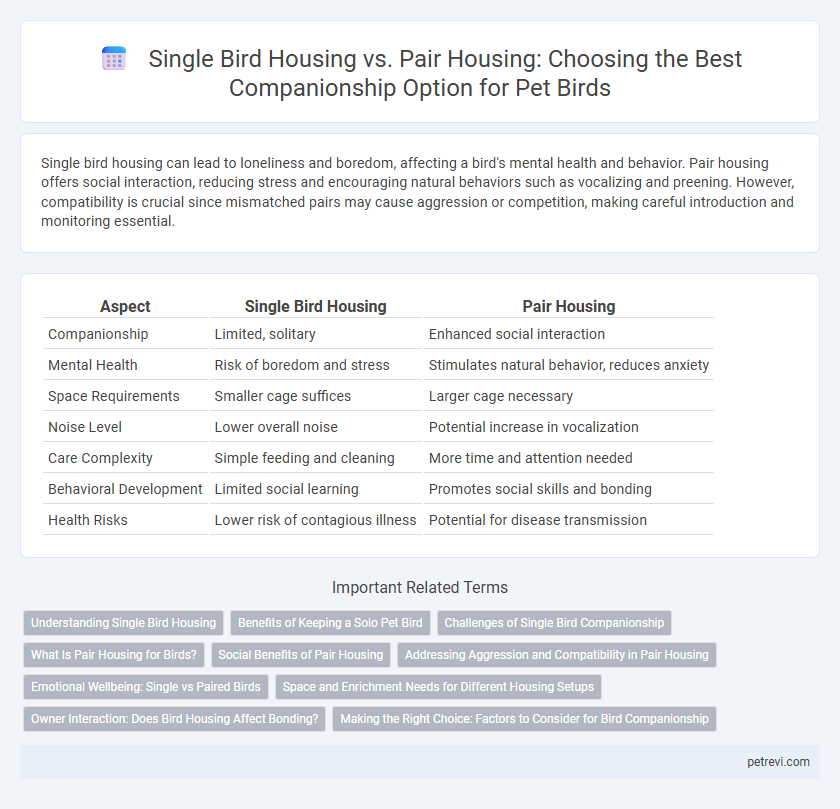Single bird housing can lead to loneliness and boredom, affecting a bird's mental health and behavior. Pair housing offers social interaction, reducing stress and encouraging natural behaviors such as vocalizing and preening. However, compatibility is crucial since mismatched pairs may cause aggression or competition, making careful introduction and monitoring essential.
Table of Comparison
| Aspect | Single Bird Housing | Pair Housing |
|---|---|---|
| Companionship | Limited, solitary | Enhanced social interaction |
| Mental Health | Risk of boredom and stress | Stimulates natural behavior, reduces anxiety |
| Space Requirements | Smaller cage suffices | Larger cage necessary |
| Noise Level | Lower overall noise | Potential increase in vocalization |
| Care Complexity | Simple feeding and cleaning | More time and attention needed |
| Behavioral Development | Limited social learning | Promotes social skills and bonding |
| Health Risks | Lower risk of contagious illness | Potential for disease transmission |
Understanding Single Bird Housing
Single bird housing provides individual space tailored to the bird's specific needs, reducing stress caused by social conflicts common in pair housing. Solitary environments allow for focused interaction with human caregivers, promoting trust and bonding without competition. Understanding the species' natural behavior is crucial in determining whether single or pair housing best supports mental health and overall wellbeing.
Benefits of Keeping a Solo Pet Bird
Keeping a single bird as a pet ensures individualized attention, allowing owners to closely monitor health, behavior, and dietary needs, reducing the risk of unnoticed illness. Solo housing minimizes territorial disputes and aggression common in pair-housed birds, promoting a calmer environment and reducing stress-related behaviors. Single bird companionship fosters a strong human-bird bond, often resulting in increased social interaction and enhanced training responsiveness.
Challenges of Single Bird Companionship
Single bird housing often leads to behavioral challenges such as increased vocalization, feather plucking, and signs of loneliness due to lack of social interaction. Birds are naturally social creatures requiring companionship, and isolation can contribute to stress and depression in single birds. Providing environmental enrichment and regular human interaction can partially mitigate the negative effects, but pairing remains the optimal solution for emotional well-being.
What Is Pair Housing for Birds?
Pair housing for birds involves keeping two compatible birds together to provide social interaction, mental stimulation, and emotional support. This environment mimics natural flock behavior, reducing stress, loneliness, and behavioral issues such as feather plucking or excessive screaming. Proper pair housing requires careful selection of species and compatibility to ensure a harmonious and enriching companionship.
Social Benefits of Pair Housing
Pair housing for birds fosters enhanced social interaction, reducing stress and promoting natural behaviors such as mutual preening and vocal communication. Birds housed in pairs exhibit greater mental stimulation and emotional well-being, which can decrease the risk of behavioral issues like feather plucking or aggression. Scientific studies show that species like parrots and finches thrive with companionship, leading to longer lifespans and improved overall health compared to single-housed birds.
Addressing Aggression and Compatibility in Pair Housing
Pair housing for birds can improve social interaction but requires careful consideration of aggression and compatibility between individuals. Observing body language and signs of stress helps identify potential conflicts early to prevent injury. Introducing birds gradually in neutral environments supports compatibility, reducing territorial behavior and promoting peaceful coexistence.
Emotional Wellbeing: Single vs Paired Birds
Birds housed in pairs generally exhibit higher levels of emotional well-being compared to single birds, as social interaction is crucial for their mental health and stress reduction. Single birds may experience loneliness and boredom without companionship, leading to behavioral issues such as feather plucking or excessive vocalization. Providing a paired environment mimics natural social structures, promoting emotional stability and overall happiness.
Space and Enrichment Needs for Different Housing Setups
Single bird housing requires ample space tailored to the species' size and activity levels, ensuring sufficient perching, flying, and foraging areas to prevent boredom and stress. Pair housing demands even larger enclosures to accommodate social interaction, reduce territorial conflicts, and provide multiple enrichment options such as toys, swings, and shared foraging opportunities. Proper spatial design and environmental complexity in both setups significantly enhance mental stimulation and physical health for companion birds.
Owner Interaction: Does Bird Housing Affect Bonding?
Single bird housing often leads to increased owner interaction as the bird relies solely on the owner for social engagement and stimulation. Pair housing can reduce owner bonding since birds primarily interact with each other, lessening the need for human companionship. Owners seeking a strong personal bond should consider single housing while balancing the bird's social and emotional needs.
Making the Right Choice: Factors to Consider for Bird Companionship
Selecting between single bird housing and pair housing significantly impacts your bird's social well-being and behavior; species like parrots thrive with companionship to prevent loneliness and behavioral issues. Consider factors such as species-specific social needs, space availability, and your ability to monitor interactions to ensure safe, positive relationships. Proper enrichment, adequate cage size, and regular social interaction are essential whether housing singly or in pairs to promote mental and physical health.
Single Bird housing vs Pair housing for Bird companionship Infographic

 petrevi.com
petrevi.com